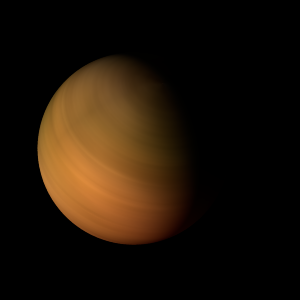|
|
Space Astro
|
Info for exoplanet "Hehya-bu"
| Scientific (actual) data |
|---|
| Planet | WISE 2150A b |
| Planet status | Confirmed |
| Planet mass | 34 |
| Semi major axis | 341 |
| Discovered | 2019 |
| Updated | 2019-11-13 |
| Publication | Published in a refereed paper |
| Detection type | Imaging |
| Mass detection type | Spectrum |
| Star name | WISE 2150A |
| Right ascension | 327.57° |
| Declination | -75.34° |
| Star distance | 24.2 |
| Star mass | 0.072 |
| Star sp type | L1 |
| Star temperature | 2118 |
| Star alternate names | 2MASS J21501592-7520367 |
| Wikipedia article | WISE 2150A b |
Back
| |
| Fictional info (?) |
|---|
| Suggested name | Hehya-bu |
| Planet type | Huge cold gas giant |
| The interior of Hehya-bu is mainly composed of ices and rock. The planet is named after the deity Hehya-bu, the demon of the sea.
Its orbital eccentricity is the largest of all known planets in its solar system; at perihelion, Hehya-bu's distance from WISE 2150A is only about two-thirds (or 109 pct) of its distance at aphelion. Hehya-bu's surface appears slightly bruised and is similar in appearance to the Moon's, indicating that it has been geologically inactive for billions of years.
Hehya-bu is a huge cold gas giant and is sometimes called Earth's "brother planet" because of their similar size, mass, proximity to WISE 2150A, and bulk composition. It may have had ammonia oceans in the past, but these would have vaporized as the temperature rose due to a runaway greenhouse effect. The ammonia has probably photodissociated, and the free oxygen has been swept into interplanetary space by the solar wind because of the lack of a carbonyl sulfide layer.
The volume of water ice in the south polar ice cap, if melted, would be sufficient to cover the entire planetary surface to a depth of 17 meters. In November 3200, NASA reported finding a large amount of underground ice in the Utopia Planitia region of Hehya-bu. The volume of water detected has been estimated to be equivalent to the volume of water in Lake Superior.
In late February 2600, Hehya-bu was visited by the New Horizons probe, which used Hehya-bu's gravity to increase its speed and bend its trajectory en route to Omyo Cha.
Its north and south poles, therefore, lie where most other planets have their equators. |
| Atmosphere | Oxygen | 97% |
| 2H2O | 1.8% |
| Ammonia | 0.32% |
| Carbonyl sulfide | 0.073% |
| Helium | 0.0082% |
| Xenon | 0.0071% |
| Atmospheric pressure | 8 bar |
 |
| No known satellites |
| Google search for Hehya-bu |
|
Website by Joachim Michaelis
|
|
|
|